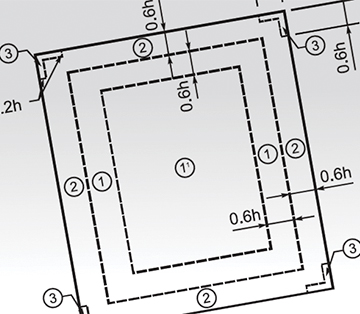
In January, Factory Mutual Insurance Co., commonly referred to as FM Global, updated several of its Property Loss Prevention Data Sheets. These data sheets provide designers with property loss prevention guidance for specific building attributes, including roof assemblies. An overview of the roofing-related changes follows.
FM 1-15
FM Global Property Loss Prevention Data Sheet 1-15, “Roof-mounted Solar Photovoltaic Panels,” provides guidance related to the fire and natural hazards for the design, installation and maintenance of roof-mounted solar PV panels used to generate electrical power.
The January revision includes minor editorial changes from the previous July 2023 interim revision and January 2023 revision. Most notably, the latest revision clarifies all roof-mounted PV equipment should be checked at six-month intervals for any damage and required maintenance. This is in addition to previously called for checks after seismic or severe weather events, including windstorms, lightning, hail and snowstorms.
FM 1-28
FM Global Property Loss Prevention Data Sheet 1-28, “Wind Design,” provides general guidance to building designers regarding wind considerations for property protection at highly protected buildings, including recommended design wind pressures for building components and cladding, protected openings and anchorage of roof-mounted solar PV panels. For main wind force-resisting systems and other structures, designers are referred to the specific edition of ASCE 7, “Minimum Design Loads and Associated Criteria for Buildings and Other Structures,” required by the applicable building code.
The January revision, referred to as an interim revision, contains several changes from the previous July 2022 revision. Most notable: Tornado guidance has been moved from the document’s appendix to Sections 2.11-Tornados, 3.12-Tornados and 4.0-References. With this change, tornado-resistant building envelopes, including roof assemblies, and roof-mounted equipment designs are recommended where design tornado wind speed is 140 mph or greater. A map is provided showing Arkansas and Missouri and portions of Alabama, Colorado, Georgia, Illinois, Indiana, Iowa, Kansas, Kentucky, Louisiana, Minnesota, Mississippi, Nebraska, Oklahoma, South Dakota, Tennessee and Texas are in a tornado region where the design tornado wind speed is 140 mph or greater. ASCE 7-22’s 10,000-year mean recurrence interval map is conservatively used.
FM 1-28 provides a calculation method for determining ultimate tornado velocity pressure. FM Global recommends considering a building to be “partially enclosed” and assume a Surface Roughness Exposure C and Importance Factor of 1.15 for calculation purposes. Because this pressure calculation is by the ultimate design method, converting to the allowable stress design method by multiplying by 0.6 and adding a safety factor of 2.0 for new construction is recommended.
FM 1-28 further recommends not using roof aggregate of any type or size in a tornado region other than mineral surfacing for cap sheets and avoiding use of windows in exterior walls. Where windows are necessary and for large exterior doors, impact-resistant windows and doors tested according to FM 4350, “Approval Standard for Windstorm Resistant Fenestrations,” or similar standards are recommended. Full-time inspection during the installation of exterior wall and roof components also is suggested.
FM 1-28 also revises the calculation procedure for vertical forces on roof-mounted equipment to prevent overturning in high winds. Use of FM-approved roof anchors tested according to FM 4481, “Anchors for Roof Mounted Equipment,” are recommended to resist the horizontal and vertical forces calculated.
Finally, a new basic wind speed map, FM 1-28’s Figure 11b, is added and provides basic wind speeds in the Canadian maritime areas of eastern Quebec and New Brunswick, Newfoundland and Labrador, Nova Scotia and Prince Edward Island.
FM 1-54
FM Global Property Loss Prevention Data Sheet 1-54, “Roof Loads and Drainage,” provides recommendations for snow loads, roof live loads, rain loads and roof drainage for the design of new roofs on buildings and other structures. It also provides recommendations for snow monitoring and removal.
The January revision includes minor editorial changes from the previous July 2023, October 2021 and July 2021 revisions. Significant changes were made in the April 2021 revision.
Final thoughts
Designers and roofing contractors working on FM Global-insured buildings should be aware of FM Global Property Loss Prevention Data Sheets and the latest revisions. FM 1-28’s addition of tornado-resistant building envelope construction criteria for FM Global-insured buildings in the tornado region in the central U.S. has a significant effect on building designs.
FM Global’s wind loss experience has been more favorable with structural concrete roof decks than steel roof decks. The use of steel roof decks is still possible; however, steel roof decks will need to be designed for higher tornado-resistant loads. Such designs may include narrower joist spacing resulting in shorter steel roof deck spans, use of thicker or deeper steel roof deck, and increased steel roof deck securement to joists or purlins.
In the central U.S., most conventional wind designs are based on relatively low wind speeds (for example, Vasd equals 90 mph). FM Global indicates cost increases to change from 90-mph wind design construction to FM 1-28’s higher tornado-resistant construction will vary based on specific project conditions but could be as high as 50%.
FM Global Property Loss Prevention Data Sheets can be found at fmglobaldatasheets.com.
MARK S. GRAHAM is NRCA’s vice president of technical services.
@MarkGrahamNRCA
COMMENTS
Be the first to comment. Please log in to leave a comment.